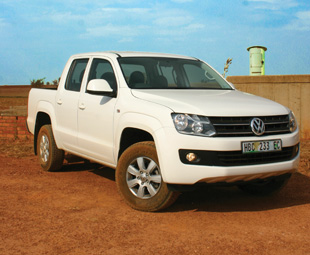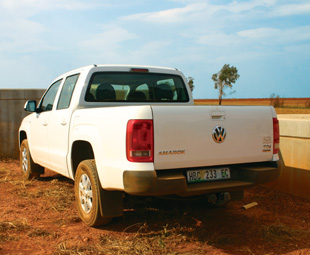A power upgrade

Now three years old, Volkswagen has endowed the Amarok range with its second engine upgrade. GAVIN MYERS ventures out in the new TDI
Three years ago South Africa was, of course, in the grip of “World Cup fever”. But another significant event also took place in 2010: Volkswagen South Africa (VWSA) launched the Amarok – its contender in the hotly contested double cab bakkie market. Some months later, in 2011, came the single cab version.
During those early days, eyebrows were raised at the fact that the range was offered with “mere” two-litre engines. And, as far as the diesel engines were concerned, mention was made of their comparatively lower output figures and whether the small-capacity powerplants would cope with the stresses demanded of them when carrying a load or traversing a rocky mountain pass – or both.
Over time the powertrains have proved to be solid, but the company took note of the concerns surrounding power output. To this end, the more powerful Bi-TDI motor received a 12 kW power hike last year. Earlier this year it was the turn of the lower-powered (single turbo) TDI, which received a power boost from 90 kW at 3 750 r/min to 103 kW at a lower 3 500 r/min. The maximum torque figure of 340 Nm (originally at 1 750 to 2 250 r/min) remains unchanged, but it is now available between 1 600 and 2 250 r/min.
The upgraded powerplant certainly feels stronger, if a little lacking in outright grunt. Coupled to a short-ratio, six-speed gearbox, the new TDI zips through the gears with a reassuring, sustained tug once on the
1 600 r/min torque plateau.
 Our unit was also fitted with the 4Motion selectable four-wheel drive – including rear diff-lock and Off-Road function – which provided sure-footed and reassuring manners during some dirt-road driving. Ride, handling and comfort on any surface are as one expects from the Amarok – pretty much best in its class.
Our unit was also fitted with the 4Motion selectable four-wheel drive – including rear diff-lock and Off-Road function – which provided sure-footed and reassuring manners during some dirt-road driving. Ride, handling and comfort on any surface are as one expects from the Amarok – pretty much best in its class.
VWSA claims the new Amarok TDI will use only 7,7 l/100 km in the combined driving cycle, while emitting 203 g/km of CO2. It indeed proved to be a frugal runner during our time with it.
The upgraded TDI’s payload is now 881 kg, up from 872 kg. As with other Amarok models, the vehicle has a 2,52 m2 load box that measures 1 555 (l) x 1 620 (w) x 508 mm (h) and gross vehicle and gross combination mass ratings of 2 820 kg and 5 500 kg respectively.
Being a Trendline model, our test vehicle was fitted with black plastic rear bumpers and 16-inch wheels. It is also distinguishable from Highline models by the absence of flared wheel arches. The interior is fitted with VW’s Climatic semi-automatic air-conditioning and a four-speaker radio MP3 player.
Our unit was fitted with a R2 100 six-speaker upgrade and R7 400 leather seats – the options list for Trendline models will bump the price up – but the standard features list is nevertheless comprehensive. The vehicle retails at R435 500 and comes standard with a five-year/90 000 km service plan, a three-year/100 000 km warranty.
The upgraded TDI powerplant is a joy to use and really makes the “smaller” engine quite appealing. However, it is quite expensive and slightly down on some features when compared to some direct rivals, and might present a more attractive proposition if one can opt for the 4×2 instead.
Published by
Focus on Transport
focusmagsa




